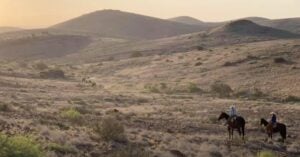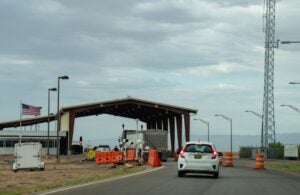Three ranching families describe their first-hand encounters with nefarious individuals passing through isolated land in the Southwest U.S.
Raising cattle is dangerous under normal circumstances, and families give serious thought to the risks of this agricultural life and the impact it has on loved ones. However, ranchers on the United States-Mexico border have it more dangerous than most, frequently sharing their land with a host of uninvited immigrants, drug runners, human traffickers, and cartels.
That requires continuous vigilance of ranchers on the border and, at times, adjustments to what should be everyday life to ensure safety.
On the Bar W H Ranch, located 90 miles from the border in southern New Mexico, rancher Colt Howland says that dead bodies are a relatively frequent occurrence. It’s a situation that might shake most people, but if U.S. Border Patrol wasn’t the one to find the body, Howland makes sure they’re the first ones to get the call.
Despite a constant flow of illegal traffic through his property, he said in a stony tone, “You’ve just got to live your life.”
Ranchers in New Mexico, Arizona, and Texas bear the brunt of illegal border crossers, but the hazards are far-reaching. The McGibbon family — which includes Andrew, Micaela, and their four children — raise red Angus cattle on the Santa Rita Ranch in southern Arizona, 40 miles from the U.S.-Mexico border.
“It scares me,” Micaela McGibbon said about the dangers of raising her family along the border. She grew up just west of the ranch and remembers riding horses in the surrounding mountains, coming home by sunset, and working her show steers at the corrals.
Things then seemed to change in the late 1990s.
By then, the volume of illegal crossers had increased so much that McGibbon’s father decided the risks were too high. The family began finding stashes of guns hidden in dry washes and realized that illegal traffic was a threat to the safety of their loved ones.

“My dad said, ‘No. It’s just too dangerous. I can’t let you go out by yourself anymore.’ And, since then, nothing’s changed.”
Because of that, the McGibbon kids have received a different kind of upbringing than the freedom that many might imagine when they think about farming and ranching in some of the most rural parts of America. They no longer feed livestock or work their show steers alone or after dark, and they’ve learned what type of people to be on the lookout for — and to run home if they hear the dogs barking.
“It’s a matter of safety,” McGibbon said. “The people coming across our ranch are the ones who have to walk the desert because they have criminal records or drugs and can’t afford to get caught.”
As with many families on the border, the McGibbons are never without a firearm. For them, it’s not a matter of shooting anyone but of protecting their families.
The family understands the reality of how people in dire straits go into “survival mode.” By the time people are three days into their walk through the desert, McGibbon said that it doesn’t matter how nice of a person you are: “That puts everyone in danger, especially women.”
Her experiences are shared throughout border communities and ranching operations, where help can be hours away, and uncertainty, risk, and fear are commonplace.
In the middle of child trafficking
In June 2023, McGibbon and three of her children were heading home late from soccer practice in Tucson. The family had a call about cows loose on a stretch of highway known for light but fast traffic.
McGibbon told her 15-year-old daughter to push the cows up the road while the other two siblings headed to the next driveway and parked perpendicularly to the road to slow any traffic and shine light on the road.
As people descended from Madera Canyon, a popular birdwatching spot at the end of the highway, McGibbon’s older daughter and 9-year-old son flashed the lights in the family’s SUV to alert oncoming traffic about the livestock.
Suddenly, a black Ford Expedition came to a stop next to the family’s vehicle.
“A dozen little kids, ranging from about 9 to 14, jumped out of the Expedition and ran to my car. My daughter jumped back into the car, rolled up the windows, and locked the doors as the kids began scrambling to get inside,” McGibbon said, describing what her kids told her. “They were grabbing door handles and banging on the windows. My 9-year-old was telling his sister to go. But, she didn’t want to run over any of the little kids.”
That was when a red SUV showed up, flashing its lights. The kids got inside.
“My son was distraught, and my daughter was rattled, too,” McGibbon said. “I was thinking that we could go back to pushing cows into the pasture, but then I realized that this was obviously a child-trafficking case. And they could have easily grabbed my daughter off of the road as they drove by. That realization took my breath away.”
But that wasn’t the end of their harrowing evening. As the family sat, lights off, discreetly waiting for the other vehicles to clear out, they realized that the black Expedition that had dropped off the kids was lingering.

Soon, the McGibbons made the decision to leave.
“He [the driver] knew that we knew what was going on,” McGibbon said. “We were a threat to their whole kid-trafficking operation at that point.”
After calling emergency services, the family was patched over to the U.S. Border Patrol, who thanked them for their time, asked them to follow up with any other information, and to be careful because they didn’t have any agents in the area.
Two days later, McGibbon ran into a sheriff on their ranch road and replayed what had happened to her family. She said the sheriff noted that he hadn’t heard a word about the incident but that law enforcement’s response should have been fast, complete with lights and sirens.
“It rattled all of us. We have to do our own advocating for our own safety because our stories don’t get heard by anyone,” McGibbon said. Those kinds of experiences don’t just impact protectors and adults in the family. The next day, her 9-year-old son asked her to get the windows tinted and to get a different car.
Hypervigilance has become a necessary practice
The rugged hillsides of border ranches bring a new meaning to “the hills have eyes.” Ranching there means that someone, usually cartel scouts, knows who you are and where you are.
“Ranch life is hard enough as it is. There’s always something that can happen danger-wise. Still, then you add in the danger of running across drug runners or illegals,” said Erica Valdez, who, along with her husband and 17-year-old daughter, raise cattle near Animas, New Mexico.
Ranchers often run a bare-bones crew, but aside from families working together on the ranch, they often want their children to experience the ranch life. They find themselves standing their ground near the border with extra vigilance to make life as normal as possible for their families.
Valdez reminds her daughter and friends who may be on horseback while working cattle to keep their eyes up and off their phones, looking for any signs of people and danger along the ranch terrain.

Situated 20 to 40 miles away from the border, Valdez’s ranch has seen hosts of immigrants come through in recent decades. But, since high school, Valdez said that the type of immigrants crossing through the family’s ranch has shifted.
And it creates an uncomfortable dynamic — one that can be difficult to talk about because they never know who’s watching what they say or reading what they write.
“We had a few cartel threats, so I hadn’t shared much about what was going on for at least five years, until 2021,” said Valdez. That year, she began telling her story again after an encounter prompted her to make a social media post.
Despite the well-recognized dangers for women along the border, Valdez’s ranch runs an all-female crew, trading work with neighboring ranches.
One day in 2021, Valdez sent her daughter and the rest of their crew down a heavily trafficked canyon.
“I just knew they were going to come across someone. I wore my horse out that day, topping out over the ridge, trying to make sure they were all OK,” Valdez said. “Everything ended up OK, but when I got home, I was fired up about the situation and posted about it on Facebook, and that’s how I ended up involved in the border conversation again because of my big mouth.”
During another gather, Valdez was riding in a similar canyon. As her horse took a break, she looked up to find four heavily armed men in military camouflage with masks and drug packs watching from underneath a juniper.
She had to ride past them to continue looking for cattle, but upon returning the next day, she found no trace of the men having been there except for a spotter’s camp on top of a nearby peak.
Valdez explained that scouts with high-tech radio equipment and firearms will sit on the hillside in a camp, keeping an eye out for Border Patrol or other threats. It’s a sobering realization that not only was a rancher seconds away from potentially being shot, but Valdez observed that her daughter could also have been in the crosshairs.
“Just the other day, my daughter went out to check the water and came across a group of illegals at dusk. Visibly shaken, she got home and told us, ‘I didn’t shut the gate,'” Valdez said. “She says she doesn’t want to go out again at dusk, and we won’t make her.”
Break-ins and what gets left behind
Despite being 90 miles from the border, Howland’s ranch is just three miles from the nearest Border Patrol checkpoint.
Border Patrol regularly uses his house on the Bar H W Ranch as a command post. Howland’s relationship with the border agents is stronger and more positive than that of many other ranchers whom AGDAILY has spoken with. However, despite law enforcement’s strong presence, Howland said that illegal traffic, drugs, and theft are regular occurrences on the ranch.

While parents may worry about their kids running into the wrong crowd in school or taking the opportunity to try illicit substances, families on border ranches are in frequent contact with drug smugglers and their products.
When he was 15, Howland’s son found a bag in a cistern on the ranch. The bag was filled with cocaine, burner cell phones, and a pistol. All of the items were turned over to law enforcement, but he said it’s difficult to imagine how many other dangerous, unreported, and illegal items make their way across the border.
The Howlands have long looked forward to fair time each year, where their son could exhibit cattle raised on the ranch. But twice, while away at livestock shows, the family experienced break-ins and theft.
The first time, Howland and his son returned home to find that people had broken into the home, slept in their beds, stolen clothing, and pulled all of the food into the kitchen. It’s almost like a story of Goldilocks and The Three Bears, but one that represents a larger and grimmer picture.
“They didn’t take my clothes, but they stole my son’s,” Howland said stoically. “Every bit of food that was in the refrigerator or freezer was out on the counter. It was really strange.”
When Howland and his son were away at another livestock show, his stepdad called to ask if he’d loaned out his son’s truck. He’d come to feed livestock and discovered the pickup missing. Several days later, law enforcement found it heavily damaged, parked near a suspected stash house in the next town over.
While the Howlands are always armed, they try not to let the threat of illegals crossing through change their daily habits. Whether it’s food, pickups, or even their water bottles getting stolen out of their cooler, keeping Border Patrol apprised of the goings-on is part of that rhythm.
For families such as the McGibbons, Howlands, and Valdezes, border life demands a different type of vigilance.
Despite those challenges, ranchers persist, rooted in their strong connection to the land and a commitment to preserve their businesses, heritage, and way of life. They’re driven by an unwavering dedication to a borderland existence characterized by resilience and resolve.
This article is the second in a three-part series delving into the unique hazards for ranchers who operate near the border with Mexico and how they respond to a changing landscape that includes illegal immigration, drug cartels, and human trafficking. The explorative series, titled The Dangerous Divide, is an AGDAILY exclusive.
Heidi Crnkovic, is the Associate Editor for AGDAILY. She is a New Mexico native with deep-seated roots in the Southwest and a passion for all things agriculture.



